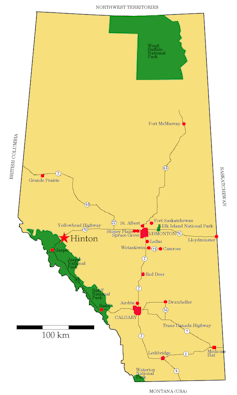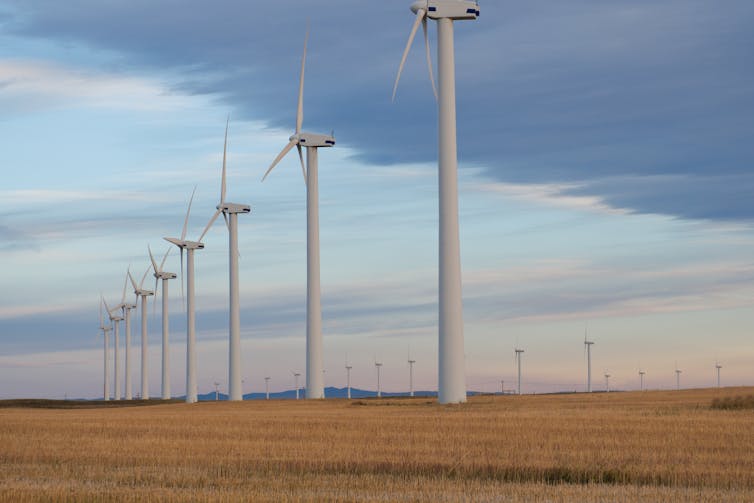Ian Urquhart, University of Alberta
Those advocating for a green transition have, in recent years, had to contend with not just economic or political resistance, but ideological push back as well — specifically, from those adhering to the “ideology of fossil fuels.”
The ideology of fossil fuels is characterized by an inability to imagine life, or progress, without petroleum products. In politics, this ideology influences the positions of left and right alike. It even encourages those on the centre-left to support oil and gas while also endorsing green energy.
In Alberta, we saw this when former Premier Rachel Notley enthusiastically supported the Trans Mountain pipeline expansion and increased renewable electricity production.
On the right, conservatives see in this ideology the vindication of their love of business and fossil fuel producers above all else. Project 2025, proposed by the Heritage Foundation, a leading American conservative think tank, reflects this mentality. The United Conservative Party government in petroleum-rich Alberta also sings from this hymn book.
Growing green in Alberta
For decades, Alberta has been one of North America’s most important oil producers. Today, only Texas pumps more oil than Alberta.
However, Alberta’s oil producing stature has camouflaged the province’s emergence as a green energy leader.
One Alberta energy regulator observed that renewable electricity production was growing “by leaps and bounds.” The Canadian Renewable Energy Association reported that 75 per cent of the country’s new renewable electricity generation came from Alberta in 2022.
Rystad Energy, the international energy consultancy, predicted Alberta would be Canada’s largest wind and solar electricity producer by 2025.
The biggest contributors to Alberta’s revolutionary potential? A mixture of industry-wide technical changes and a market where generators are paid only for the power they generate. These changes in the solar sector drove down solar costs by more than 80 per cent between 2009 and 2023 and electricity sector greenhouse gas emissions fell by 51 per cent from 2015 to 2021.
The data seems clear, renewables have a secure, and growing, position in Alberta’s electric grid.
Inquiries
Last summer Premier Danielle Smith fired the first shot in her campaign against renewables. In early August, Smith imposed a seven-month moratorium on all new renewable generation project approvals.
The moratorium came despite the significant investment and employment benefits Alberta’s renewables sector had started to deliver. Between 2019 and 2023, $3.75 billion was invested in Albertan utility-scale wind and solar projects; 4,500 workers were hired.
Key government rationales for the moratorium lacked evidence. The government said Alberta needed a moratorium plus a public inquiry into the land use impact of renewables. Why? Because of unspecified concerns that renewables posed significant threats to Alberta’s best agricultural lands and to “Alberta’s pristine viewscapes.” The province instructed the Alberta Utilities Commission (AUC) to conduct this inquiry.
The inquiry didn’t find any support for this government rationale. Several participants in the inquiry (myself included) offered research showing that renewables have made, and likely will continue to make, a marginal contribution to converting Alberta’s best agricultural lands to renewable electricity production.

The commissioners listened. They observed that renewables weren’t primarily responsible for any historical loss of these lands. Furthermore, they endorsed the findings of a renewables “worst case scenario” for prime agricultural lands. This scenario imagined locating all the renewables needed to reach net-zero in electricity by 2035 on the best farming land. This would remove less than one per cent of these lands.
Approximately 0.4 to 0.6 per cent of today’s best lands would need to be converted if solar alone was the vehicle to reach net-zero. The 31,125 hectares needed to realize the solar-only net-zero scenario is just 61 per cent as big as Waterton Lakes National Park in the southwest corner of the province.
The government dismissed these observations and adopted an “agricultural first” policy. The policy prohibits renewable projects from locating on prime agricultural land unless projects can share the land with agriculture. While the AUC saw promise in sharing the land (a process known as agrivoltaics), they told the government this option “would benefit from further study.”
Ideological drivers
What links the Alberta government’s agriculture first policy to a fossil fuel ideology? It’s refusal to impose any similar land use restrictions on exploiting oil and gas. The commission observed that pipelines and non-renewable industry are responsible for the greatest loss of agricultural land recently. Those activities, not renewables, would be more appropriate targets.
Protecting “pristine landscapes” also revealed the fossil fuel ideology’s importance. The commission noted how difficult it was to agree on what the government’s phrase meant. It was simply impossible to agree on what a pristine landscape actually looked like. Faced with this impossibility, the AUC left it to government to decide what, if any, viewscape qualified as pristine.
But the commission suggested that protecting viewscapes should be “industry agnostic.” Viewscape prohibitions should “apply equally to all forms of development within the restricted zone, not just electricity generation.”

The government did not follow this suggestion. Its minimum 35 kilometre “pristine viewscape” buffer prohibits all new wind projects. Solar projects also may need to pass a visual impact assessment as part of the approval process.
These viewscape restrictions do not apply to new oil and gas projects.
Beyond these issues, a fossil fuel ideology also animates other provincial policies designed to expand petroleum production. Billions in subsidies for carbon capture projects and intense opposition to a proposed federal cap on oil and gas emissions demonstrate this.
Similar opposition to federal draft clean electricity regulations and a new annual registration fee for electric vehicles also confirm the prominence of an ideology of fossil fuels in contemporary Alberta conservatism.
While the UCP in Alberta may, at the moment, be the primary culprit in this assault on green development, it is important to remember that a fossil fuel ideology is not inherently driven by party politics. Understanding this can help us all to more effectively keep both conservative, as well as future left-leaning, governments to account.
Ian Urquhart, Professor Emeritus, Political Science, University of Alberta
This article is republished from The Conversation under a Creative Commons license. Read the original article published April 16, 2024.












